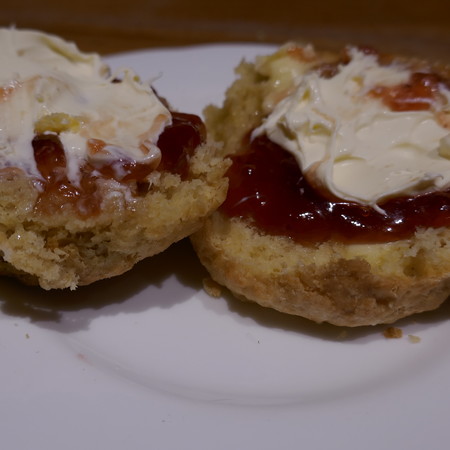Oven Scones
|
The unofficial requirements of some field staff when involved with voyages round the UK and Ireland is to make sure that the quality of the local produce, of which the guests may chose to partake when off the vessel, is up to scratch. As part of these onerous duties I have taken it upon myself to become the quality control supervisor for the scones in the various teashops that are adjacent to some of the localities we visit. In short, I am a SCONNOISSEUR. It is all too easy to determine the scone that has suffered the indignity of having been frozen and thawed, as the texture changes subtly and tends to crumbliness and dryness. The heinous mistake often propagated is to discover scones that have been overworked in the making and therefore are lacking the exquisite lightness of good baking. In my serious researches I have drawn up a short list of “sconeries” but the current front runner for taste, texture and size are the scones from a teashop in Orkney, the exact location of which must remain a secret to avoid the possibility of a scone famine on my next visit. Now for the cognoscenti, it is all too easy to disguise a poor quality product and incorporate fruit or cheese, but these should be avoided by the expert. You should home in immediately for the plain scone where any imperfections are not so easy to hide. Now I am not going to get involved in the perennial arguments about Cornish or Devon cream teas – whether the cream or the jam goes on first, but as the jam tends to be more “sticky” then it makes perfect sense, to me at least, to put jam on first and then the cream on top. Scone ingredients are simplicity itself, the secret lies in the mixing and moulding. Chris Edwards Expedition Staff |

Ingredients
| 340g plain flour, sieved for lightness |
| 55g butter |
| 2 tbsp granulated sugar |
| 1 tsp baking soda |
| 2 tsp cream of tartar |
| 1 egg |
| Pinch of salt |
| Sweet milk to mix (i.e. not buttermilk) |
Method
1. Rub butter into flour.
2. Add sugar, salt, baking soda, cream of tartar.
3. Whisk egg with fork and add to mixture.
4. Add enough milk to make a fairly soft dough. As soon as the moisture is added to the dry ingredients, time is of the essence. DO NOT mix with hands but use a pallet knife or similar until all the ingredients are bound into a soft dough.
5. Gently roll until dough is about 1 -2 cm thick.
6. Use a cutter dipped in flour to prevent it sticking to the dough. Press down, do not twist, which can result in mis-shapen scones.
7. Transfer pieces to baking parchment on a sheet pan and bake in a hot (circa 200C fan/ 220C ) for about 10 mins until nicely coloured on the top.
8. Allow to cool, serve with home-made blackcurrant, strawberry, cloudberry, raspberry etc jam and, if you must be extravagant, whipped or clotted cream to taste.
This recipe is transcribed from a Birsay (Orkney) Womens Institute cookbook (date unknown) and was originally written with imperial measurements. A very similar recipe is given in Marian McNeill’s “The Scots Kitchen" as “Mrs MacNab's ( of Ballater) scones”






